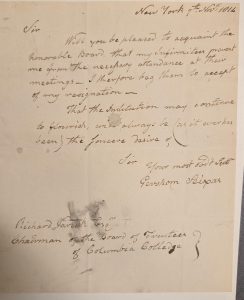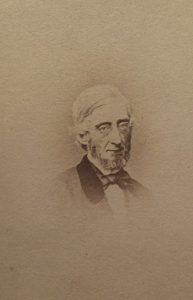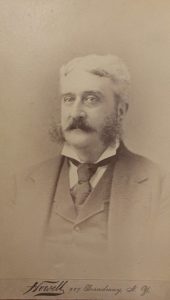Many of our posts have dealt with Jewish-related material at Columbia, focusing on the importance of the study of Hebrew to its founder and subsequent 18th century instructors, and even about finding American Jewish history in the collections. This series will focus on the Jews at Columbia through the 20th century, starting with its first 100 years (or so). Many thanks to University Archivist Jocelyn Wilk and Records Manager Joanna Rios for their deep knowledge and assistance in gathering this information together.

Columbia was unlike many of its peers in many ways. From the first, being (as its name so proudly states) “in the City of New York” meant that the University had to be a bit more inclusive from its inception. After the American Revolution, the newly christened Columbia College petitioned the New York Legislature for a new charter. In 1783, its governing body was thus the Regents of the State of New York. The 1784 charter had an interesting requirement, that there should be regents from among the clergy representing all “respective religious denominations in this State.” The representative chosen to represent the Jewish region was Gershom Mendes Seixas of Shearith Israel Congregation, the oldest Jewish congregation in New York. Seixas remained on as a Trustee when Columbia received its own Board of Trustees in 1787, and would continue serving as a Trustee until he resigned in 1814 due to “infirmities.”
Unlike its peers at the time, King’s College – and then Columbia College – did not restrict its student body to those following the Christian faith. The first known Jewish graduate of King’s College was Isaac Abrahams, who was at the college from 1770-1774. Isaac clearly had made connections among his peers, joining in the mischief documented in the famous (or infamous) Book of Misdemeanors as “confined to College for taking Tea-cups out of another student’s room, and denying that they knew anything of them.”
On May 5, 1791, the Trustee Minutes included a note that “All students who do not observe Saturday as the Sabbath shall be obliged to perform on Saturday morning such duties as the Board of Professors shall require.” (Note that there were Christian denominations at the time that observed Saturday as the Sabbath, so this ruling may not have been specific to Jews)
Being in the City of New York also meant interactions at all levels with Jews who lived there. Prior to the Revolutionary War, King’s College President Myles Cooper acted as a courier for a Bible manuscript owned by a Jew named Sampson ben Joseph Simson in New York to London for the use of Benjamin Kennicott in his monumental work on the Hebrew Bible in the late 18th century. Simson’s nephew, called (very similarly) Samson, gave a commencement address in Hebrew at Columbia in 1800 which was written with the assistance of Gershom Seixas, the Jewish Columbia Trustee from 1787-1815. (For more on the address, see: Isidore S. Meyer, “The Hebrew Oration of Sampson Simson,” in Publications of the American Jewish Historical Society, Vol. 46, No. 1 (September, 1956), pp. 51-58). In addition to his oration, Simson (the younger) also left a bequest of $1000 to the College in 1857 “to be applied for the purchase of law books.” It was the first financial bequest by an alumnus to the College.

Walter Jonas Judah enrolled at Columbia College in 1794. According to a citation from the family ledger in David de Sola Pool’s Etched in Stone: Early Jewish Settlers 1682-1821, Walter’s brother Benjamin paid 16 pounds for Walter’s classes on November 17, 1797. Walter worked to treat the sick in New York during the smallpox epidemic of 1798, and he died from smallpox that year. Judah was buried in the first She’arith Israel cemetery at 55 St. James Place in the Bowery, and his grave is still there to this day. The text on his gravestone is transcribed at findagrave.com (Memorial ID #26671933 ):
Hebrew (translation to English from findagrave.com):
Here lies buried/the unmarried man/
Old in wisdom/Tender in years/
Skilled he was in his labor, the labor of healing/
Strengthening himself as a lion and running swiftly as a hart to bring healing/
to the inhabitants of this city treating them with loving kindness/
when they were visited with the yellow fever/
He gave money from his own purse to buy/
for them beneficent medicines/
But the good that he did was the cause of his death/
For the fever visited him while yet a youth in his 21st year/
Declare him and his soul happy/
May they prepare for him his canopy in paradise/
And there may he have refreshment of soul/
until the dead live again and the spirit re-enter into them/
Joshua the son of Samuel/departed hence/on the holy Sabbath day/the 5 of Tishri/in the year/and thou shalt rest/and stand in thy lot on the end of days/5559 Daniel XII, 13/May His Soul Be Bound Up In the Bond of Life
English:
In Memory of Walter J Judah
Student of Physic, Who Worn Down
By His Exertions to Alleviate the
Sufferings Of His Fellow Citizens
In That Dreadful Contagion
That Visited the City of New York
In 1798 Fell A Victim in the Cause
Of Humanity the 5th of Tishri
A.M. 5559 Corresponding
With the 15th of September 1798
At 20 Years 5 Months 11 Days

In 1816, Daniel Levy Maduro Piexotto received his A.B., followed by an M.D. in 1819 and an A.M in 1823. Peixotto was the son of Moses Levy Maduro Peixotto, the rabbi who succeeded Gershom Seixas at Shearith Israel (clearly Shearith Israel had quite a few Columbia connections during this time!). Daniel L. M. Piexotto’s wife, Rachel M. Seixas, was a descendant of Gershom Seixas. Piexotto was very involved in the field of medicine, serving as the Secretary at the short-lived (1825-1830) Academy of Medicine, and eventually became president of Willoughby Medical College in Cleveland. He also taught Hebrew at a Mormon Temple in Kirtland.
Jonathan Nathan received his A.B. in 1826 and his Master in Chancery (a kind of law degree) from 1840-1845. He maintained a close relationship with his college classmate, Hamilton Fish, Sr., and the library has a collection of letters written from 1843-1857 to his school friend. One particularly interesting letter in the collection addresses his Jewish practice: “I am anxious to come up now as our Passover Commences on Wednesday when our system of dietetics will keep me home for a week…”

Israel Moses received his A.B. in 1841, his A.M. in 1844, and his M.D. in 1845. Moses had quite an active career, serving as a surgeon in the US Army during the Mexican War from 1847-1848, and then as Attending Surgeon at Jews’ Hospital in New York (which would become Mt. Sinai). He achieved the rank of Lieutenant Colonel during the Army fighting for the Union, and wrote a paper called “Surgical Notes of Cases of Gunshot Injuries Occurring During the Advance of the Army of the Cumberland in the Spring of 1863.”
Robert Weeks Nathan (incidentally, the brother of Jonathan!) went to Columbia College in 1848, but did not complete a degree. From the Columbia perspective, his claim to fame is as the father of the founder of Barnard College, Annie Nathan Meyer, about whom we’ll learn a great deal more in the next post in this series.

Coming next is “Jews at Columbia 1854-1900: Jewish Studies – and rumblings of difference.”
Fascinating glimpse into the early Jewish presence at Columbia University! It’s incredible to see how this community’s contributions shaped the institution’s history.